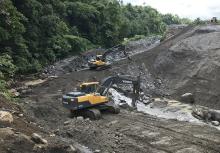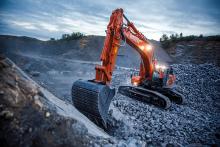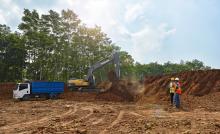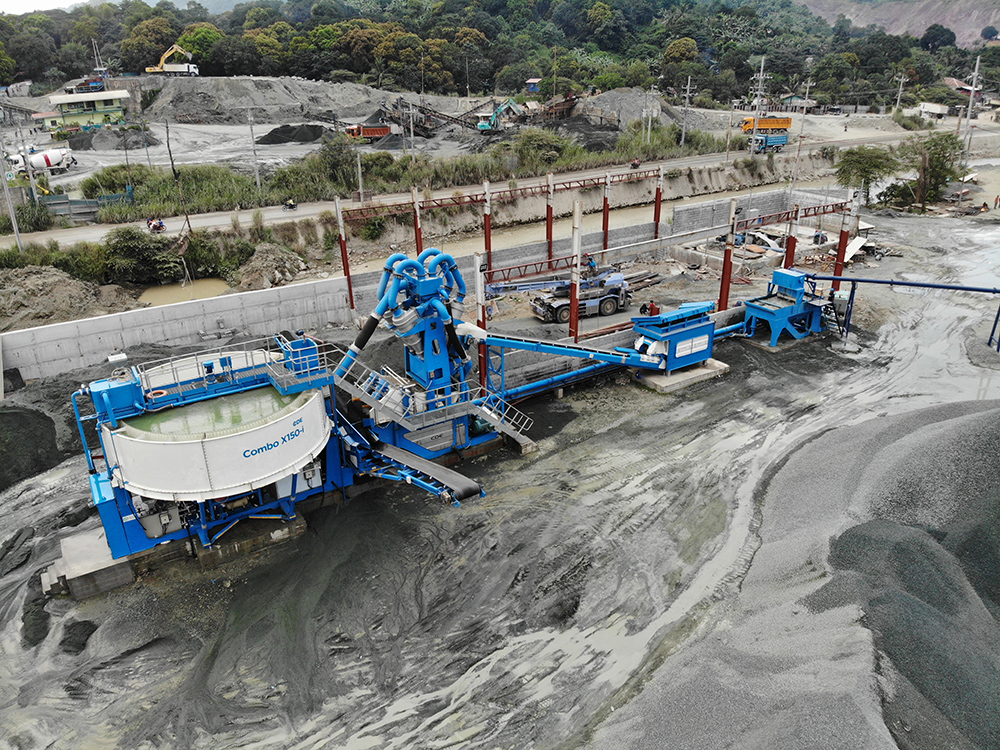
The resumption of construction projects and new investments is set to improve prospects for quarrying and aggregates in the South East Asian countries of Vietnam, Thailand and the Philippines in 2022.
Construction – and associated demand for aggregates - has been impacted across all three nations over the last two years due to COVID lockdowns reducing mobility and building activity.
Vietnam saw 20% less construction in 2020 and the first half of 2021, while there was a 13% reduction in the demand for cement in the Philippines, according to Alexander Baart, regional director South East Asia for wet processing equipment manufacturer CDE. He says the good news is that public and larger projects are now resuming across the South East Asia region.
“From today’s perspective there are reasons to believe that after Lunar New Year [February 1] in Thailand and Vietnam the volumes will grow back to pre-COVID levels,” says Baart. “In the Philippines we already foresee a 6% higher demand of cement compared to 2019.”
Baart adds that a growth of 6% is expected this year in Thailand’s construction business, while in Vietnam it is expected to be between 3 and 5%. In both countries the driving force is the resumption of new projects.
Market analyst GlobalData says that the South Asia region (including Vietnam, Thailand and the Philippines) should generate construction output values in 2021 that will surpass the 2019 pre-COVID levels in real (constant prices) terms.
ASEAN Analytics highlights three of the biggest public infrastructure initiatives in the region that could contribute to aggregates demand as being the Northeastern High-Speed Rail project in Thailand, Long Thanh International Airport in Vietnam, and the new Manila International Airport in the Philippines.
COVID has put a dampener on the economy in Philippines and is still affecting logistics flow in the country, according to Peh Jing Peng, Volvo CE’s head of market for Philippines, Taiwan and Brunei.
“Philippines is currently suffering from the Omicron wave of infection which is still growing,” says Peng. “Nevertheless, the government has put an emphasis on the construction industry to boost the economy. This is helping the quarry and aggregates sector.”

GlobalData estimates that the Philippines construction industry recorded an annual growth of 21.9% in 2021, with output predicted to surpass pre-pandemic levels in 2023. The analyst adds that the sector’s output in the second half of 2021 was supported by improving investor confidence and investment in transport, renewable energy, residential and commercial infrastructure projects.
The Philippines construction industry is projected by GlobalData to expand by an annual average rate of 9.6% from 2022 to 2025. The AmBisyon Natin 2040 programme, which promotes the development of affordable housing, transport and renewable energy infrastructure, is expected to drive the industry’s long-term growth.
An increase in foreign direct investment (FDI) will also contribute to the construction industry’s growth momentum in the next few years.
Raven Chua, head of market Thailand, Laos & East Timor at Volvo CE, says that COVID-19 has heavily impacted the tourism sector in Thailand, which accounts for around 20% of the country’s overall gross domestic product (GDP).
“The Thai government has diverted much of the country’s budget to support countermeasures against COVID, especially for SMEs, which has caused delay to megaproject investments,” says Chua. “Vaccinated travel lanes opened in October 2021 but were closed again in December due to the Omicron outbreak.”
Travel in the country was re-opened from February 1, 2022 and Chua says that, as the tourism sector recovers, it will push demand for infrastructure and therefore aggregates.
Thailand’s construction industry was not as severely affected by the outbreak of the pandemic as some of its regional peers, according to GlobalData, with the industry registering an annual growth of 2.3% in real terms in 2020 - an improvement on growth of 1.6% that the construction industry recorded in 2019.
GlobalData predicts the Thai construction industry will register an average annual growth of 4% between 2022 and 2025, supported by improving investor and consumer confidence and government investments on road, rail, renewable energy and housing projects. Further supporting growth will be investment in both the Southern (SEC) and Eastern Economic Corridor (EEC) programmes. The value of approved developments in the EEC totals THB669bn (US$20.7bn), with four of the corridor’s six flagship projects currently in execution.
In the SEC, the Thai government plans to invest THB106.8bin (US$3.4bn) towards the development of 116 projects between 2019 and 2022.
Volvo CE’s Wilson Shee, head of market Myanmar, Cambodia & Vietnam, says that Vietnam witnessed a slight (10%) drop in aggregates demand in 2020, but 2021 saw higher market demand (17% growth vs full-year 2020).
Construction market output in Vietnam was valued at US$83.40bn in 2020, and GlobalData estimates it recorded moderate growth in 2021. Construction activity further contracted in Q3 2021, with construction value added falling by 20.6% year on year (YoY) due to the imposition of a sudden, strict lockdown by the Vietnamese government. Residential construction represented the largest sector in 2020 followed by infrastructure, energy and utilities, commercial, industrial, and institutional.
GlobalData predicts the Vietnamese construction industry will register a CAGR of more than 8% between 2022 and 2025, supported by ongoing construction works on the considerable pipelines of public infrastructure projects. As part of its transport infrastructure spending plan of between VND973.8 to 1,472 trillion (US$43-65bn), the government plans to construct and renovate existing road, rail, inland water, sea and air transport infrastructure in the period through to 2030.
The construction industry in Vietnam will be supported by a recovery in domestic demand and investment from the Vietnamese government’s VND117.8 quadrillion (US$5.2bn) COVID-19 support package, which was announced in August 2021. In 2022, the industry is projected to continue to grow, supported by government investment in infrastructure, residential and renewable energy projects. In addition, the road development plan for 2021-2030, which received approval from Vietnam’s prime minister Pham Minh Chinh in September 2021, will drive the industry’s growth in the coming years. The plan includes the construction of over 5,000km of expressway by 2030.
Discussing the characteristics of the three markets, Raven Chua of Volvo CE says that customers in Thailand depend a lot on the sales personnel of equipment providers to share their knowledge and experience of the quarry business.
“There is also a lot of competition in the aggregates and quarrying market, so any capital expenditure or equipment package must be attractively priced to compete, but low total cost of ownership and operation will ensure long-term success,” Chua adds.
“While productivity and reliability are basic requirements, we are now seeing customers in Thailand look deeper at total cost of ownership, especially with regards to maintenance, when renewing their fleets.”
Peh Jing Peng of Volvo CE says the Philippines has many river quarries, and excavators are forbidden by law from entering the water: “Therefore, there are many river quarries that make sure of wheeled loaders that enter the river and dredge up the river stones.”
Peng adds that wheeled loaders from brands such as Volvo-owned SDLG are frequently used in this application with some special local modifications.
In terms of what quarry equipment customers are looking for, Peng says: “Excavators and wheeled loaders are the most popular in Philippines.
“Customers look for high productivity, reliability, and low fuel consumption, as well as ease of maintenance and low capital outlay.”
Wilson Shee of Volvo CE says that the brand is a latecomer in Vietnam, with rival equipment manufacturers Caterpillar and Komatsu entering the market much earlier. “This means Volvo must go the extra mile to penetrate quarries and other segments, but this effort is paying off as Vietnamese customers come to appreciate the high productivity, high efficiency, easy maintenance, and reliable aftermarket support we offer,” Shee adds.

In terms of the equipment trends across all three countries, Alexander Baart of CDE says that crushers (jaw & cone) are the primary needs for quarry owners producing aggregates.
“In Vietnam, depending on specific application and requirement, currently VSI [vertical shaft impactor crushers] are also in demand and we are also seeing purchases of vibrating screens and conveyors being done,” Baart adds. “Regarding crushing equipment, the European manufacturers are the brands commonly well known in the premium markets, though a considerable number of operators willing to compromise on quality and performance prefer equipment from China and Taiwan.
“Apart from this, loaders, excavators, dump trucks and dozers are the high-selling equipment to quarry operators in the region. Similarly, heavy-equipment suppliers like Komatsu, Caterpillar, Volvo, Hyundai, etc. are the market leaders.”
In Vietnam, Shee says that the Volvo EC350DL and EC480DL excavators are the most popular for loading while the R60D and R100E rigid haulers are most in demand for hauling. “Productivity and cost of operation are the priority for quarry operators (tons per hour and dollar per ton are the two main measurements for quarries) so these reliable, productive, and efficient machines are ideal,” Shee adds.
Building solutions provider Holcim Philippines says it is aiming to build on its 2021 accomplishments in innovation and sustainability to further drive business performance and support the country’s progress.
Holcim Philippines president and CEO Horia Adrian states that, despite the challenges in 2021, the company's commitments remain solid.
"We pushed on with key initiatives that will contribute to our long-term success and enable us to have a more positive impact on the country’s development," adds Adrian.
In May 2021, Holcim Philippines published its first Integrated Annual Report which follows the sustainability disclosure standards of the Global Reporting Initiative.
In July, the company signed an agreement with Sinoma CBMIPH Construction to upgrade its cement manufacturing facilities in La Union and Misamis Oriental to reduce the fuel consumption, raw materials and carbon footprint of operations.
In September, the company completed storage and processing facilities at its Bulacan plant to increase usage of alternative fuels and raw materials in cement production through its waste management arm, Geocycle.
In November the company signed a 20-year power purchase agreement with renewable energy company Blueleaf Energy, to deliver solar power to its Bulacan and La Union plants. Holcim Philippines says this will make its cement plants the first in the country to be powered by solar energy.
Cement technology company FLSmidth is working as a technical consultant with Vietnamese waste-handling start-up TONTOTON to assist local cement producers in replacing fossil fuels with plastic waste.
The partners aim to cut plastic waste in Vietnam, the world’s third-largest cement manufacturing nation. Eight million tonnes of plastic end up in the world’s oceans every year. As the fourth-largest contributor to marine plastic pollution globally, Vietnam wants to buck this harmful trend, which is largely caused by an ineffective waste-handling infrastructure.
TONTOTON aims to streamline the plastic waste ‘value chain’ by collecting and recycling large quantities of plastic on behalf of major consumables companies before it reaches the ocean.
Vietnam had an annual production of nearly 100 million tonnes of cement in 2020, surpassed only by China and India. The non-recyclable plastic waste can be used in co-processing at cement plants and is therefore a perfect alternative fuel for the Vietnamese cement industry, which today is dependent on large quantities of coal and other fossil fuels.
“Together with TONTOTON, we are enabling cement plants in Vietnam to replace traditional fossil fuels with a more environmentally friendly alternative, while also tackling the tremendous waste challenges,” says Carsten Riisberg Lund, cement industry president at Denmark-based FLSmidth.
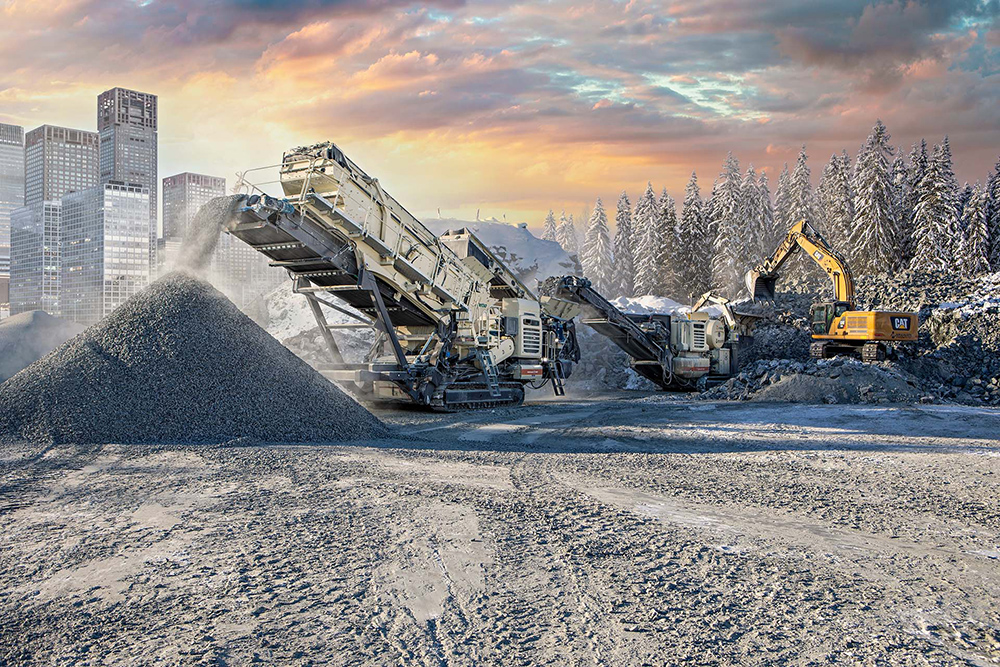
Chinese manufacturer XCMG has delivered 33 units of its new XC9 elite loader series to Israel, Thailand and European countries.
The deliveries, made on January 19 from the group’s intelligent manufacturing base for large-tonnage loaders, mean that XCMG has now reached the milestone for the cumulative export of 100,000 units of loaders.
In September 2021, Metso Outotec and Phu Thai Cat (PTC) signed a distribution contract for Metso Outotec’s aggregates solutions in Vietnam, in addition to Laos and Cambodia. The agreement includes a wide choice of Metso Outotec’s mobile, portable, and stationary crushing and screening equipment, crusher wear parts, screening media and parts.
Metso says the demand for aggregates in the territory is estimated to grow significantly in the coming few years thanks to the implementation of major infrastructure projects. Because of the development, aggregates customers are focusing more on production efficiency and output material quality that Metso Outotec’s premium crushers are suited to.
Shaun Fanning, vice president, distribution management Asia Pacific at Metso Outotec, commented: “The combination of high market demand for aggregates solutions in the region and a professional partner like Phu Thai Cat, means we look forward to an effective cooperation to grow our business.”
In the Philippines, Metso Outotec and Donum Industrial have signed a distribution contract for aggregates crushing and screening solutions.
The contract covers Metso Outotec’s track-mounted Lokotrack and Nordtrack equipment, the Nordberg NW Series wheel-mounted equipment, Metso Outotec crusher wear and spare parts and Trellex screening media.
Regarding the overall near-term outlook for the quarrying sectors in Vietnam, Thailand and the Philippines, market participants are generally cautiously optimistic.
Alexander Baart of CDE says the major challenge is the threat of new coronavirus variants that could lead to new and further travel restrictions.
“Since projects are slowly starting to move and still there are uncertainties, quarry operators are cautious on high investments, which makes it a bit challenging for producers of equipment,” Baart adds.
In terms of future trends, Raven Chua of Volvo CE says that emissions are not yet regulated for quarry operators in Thailand but global brands, such as Lafarge and Heidelberg, are giving at lot of attention to environmental impact.
“There is also popular acceptance in Thailand of the concept of moving into electric machines, with online (remote) operation, reducing operator reliance,” Chua adds. He predicts a slight increase of approximately 5% in demand for aggregates in Thailand over the next year as the government shifts more budget to road and highway contracts.
In the Philippines, Peh Jing Peng says Volvo CE expects a continued focus from customers on high productivity, high uptime, and low fuel consumption to drive profitability.
He says that aggregates demand will increase in the Philippines over 2022, and it will be heavily dependent on government investment into infrastructure. “The presidential election in May 2022 will determine the trend. The current incumbent government is sharply focused on infrastructure spending,” adds Peng.
Wilson Shee says the main growth driver in Vietnam is the Country Masterplan in Infrastructure and Road Development, where aggregates are the main raw materials required. “The Vietnam government will push for most delayed megaprojects to be completed or get back on schedule, so we expect demand in 2022 to be higher than in 2021,” he predicts.
“Vietnam is rated as one of the top fast-growing economies. Rapid urbanisation will generate high demand for construction aggregates.”

